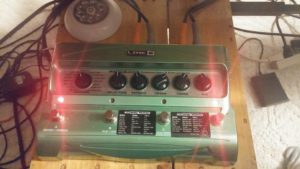“Delay is the Antidote for Anger” – Ancient fortune cookie wisdom
The Yamaha MM8 serves as my main synth for pianos, e-pianos, and the like. Its weighted keys remain a worthy challenge for someone known more as a drummer. Nonetheless, the MM8 remains a valuable part of my studio setup.

Budget constraints – always lurking – made me choose the MM8 over more expensive 88-key synths. One of the trade-offs is the lack of editing control over the synth’s built-in effects. This unfortunately comes into play on a few e-piano patches where the effect (delays, choruses, etc.) uses a “hard-coded” tempo. Thankfully, I am at least able to turn the effect off when that scenario arises.
I really like the sound of any piano through a delay where I control its time using tapping, knob, or slider. The Electro Harmonix analog Deluxe Memory Boy is part of our setup, but it is assigned to the Berlin School section of the studio, while the Moog MF Delay is essentially bolted to the Sub 37. Both delays might be in use at the same time as the MM8, so schlepping them around isn’t really an option.
I knew Line 6’s line of products used high-quality effect models, thus I had no problem pairing it with a digital synth. Enter the Line 6 DL4 Delay Stompbox Modeling Pedal.
A Closer Look at the Line 6 DL4 Delay
First released way back at the turn of the century, The DL4 features 16 delay models each with its own unique character. There is even a loop sampler. Some of the models are based on classic delays, like the Maestro Echoplex, Roland Space Echo, and the EHX Deluxe Memory Man. The 24-bit stereo signal path ensures a superior performance – as my ears can attest!
Housed in a sturdy, green case, the DL4 is powered by either four C batteries or an AC power adapter. Not being a guitarist, I ran down the batteries by keeping the cords plugged-in at least two times, so a power adapter was soon purchased. Blame the drummer or the synthesist. In addition to stereo I/O, the DL4 also provides an input for an expression pedal.
With a footprint similar to other Line 6 stompbox modelers, the DL4 sports four multifunction switches as well as six knobs. The knobs are used to switch between delay models and tweak the effect settings, while the switches handle either patch selection (there’s room for three), control of the loop sampler, or the tap tempo functionality. Don’t forget to attach the convenient stickers detailing the functions of the “Tweak” and “Tweez” knobs for each different model.
The DL4 in Action
The DL4 is very easy to use with intuitive controls and a straightforward interface. Being somewhat of a psychedelic musician, I was especially drawn to the analog echo and tape delay models. Both work perfectly for my desire to add a measure of mindfreak to the MM8’s grand piano and 70s electric piano patches. Anymore, I rarely run the Yamaha synth dry.
A typical workflow involves simply dialing in a delay model, setting the tempo to be in sync with the piece of music (by either tapping or using the “Delay Time” knob), and tweaking away until it sounds just right. Holding one of the three patch switches (A, B, or C) down until the indicator light over it flashes saves your efforts. In short, the DL4 is simply a breeze to use.
The title track of the new Church of Hed release, A Cold White Universe, depends on the DL4 delay as an essential part of sections featuring (Philip) Glassian piano ostinatos. A piece of music deriving a measure of inspiration from an effects unit is arguably the best thing you can say about a stompbox.
There is a good reason the Line 6 DL4 is known as the legendary “Green Box.” Chances are strong you need one in your studio, whether you play guitar, synth, bass, or drums, but keyboardists especially need to check it out.




Pingback: The New Apple iPad pulls me back into iOS Music | TabMuse -- a Home for Digital and Analog Music Inspiration